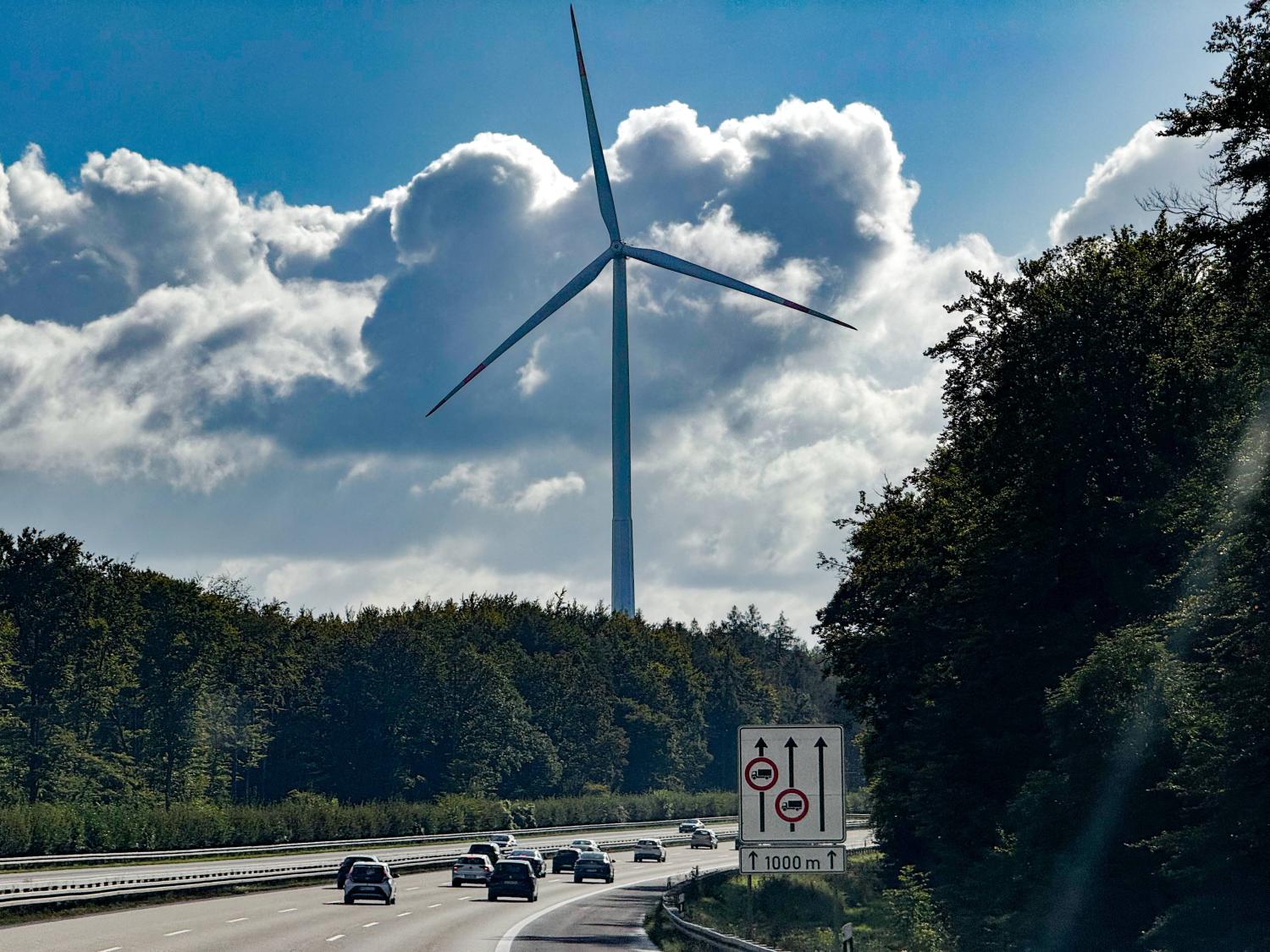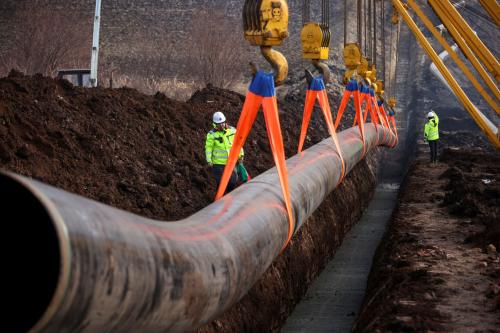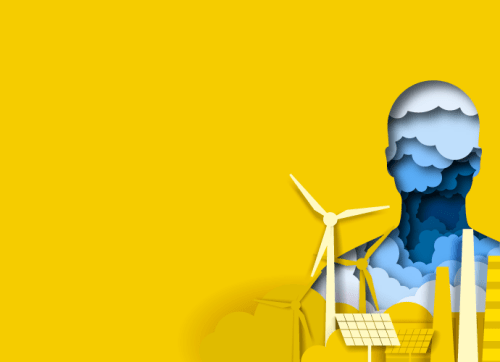This report is the second in a series on “Europe’s energy transition: Balancing the trilemma” produced by the Brookings Institution in partnership with the Fundação Francisco Manuel dos Santos.
The energy transition pathway is uncertain
The future of energy supply and demand—and the nature of energy markets and geopolitics—is highly uncertain. Even if the world’s major economies meet their common goal of net-zero greenhouse gas emissions by mid-century, how they will meet this goal is unknowable today. Society’s need to maintain access to secure and affordable energy throughout the transition adds further complexity—and urgency.
Many research groups and energy companies have created global net-zero scenarios, including the International Energy Agency’s (IEA) Net-Zero Emissions by 2050 Scenario (NZE), Shell’s Sky 2050 Scenario, and BP’s Net Zero Scenario. These scenarios are not intended to be predictions; instead, they are explorations of ways the world might achieve the climate goals specified in the Paris Agreement. With global emissions continuing to increase, it is crucial to note that the world is not currently on a net-zero pathway and that massive changes are needed in public policy, technology, behaviors, and markets to get on such a trajectory. Our discussion here focuses on net-zero scenario analyses as the outside edge of what is possible, not what is expected.
In addition, a wide range of potential pathways to a net-zero world is possible, depending on future policies, technological innovations, and consumer preferences. The chart below brings together five scenario analyses that consider the mix of primary energy supply in a world that achieves the goal of limiting global temperature rise to 1.5 degrees Celsius. All of these scenarios assume a greatly expanded role for renewable energy, but they differ considerably in the overall level of energy demand and the roles of other fuels and technologies, including fossil fuels, nuclear, and bioenergy.
Acknowledging the massive uncertainty surrounding the future global energy system, we need to be humble about our ability to make predictions and be open to surprises. The best minds have been spectacularly wrong in the past. For example, in 2003, the U.S. National Petroleum Council advised the secretary of energy that America’s natural gas future would involve large imports of liquefied natural gas (LNG). Instead, due to the shale revolution, the United States became a net LNG exporter just over a decade later (in 2016) and today is the world’s largest LNG exporter.
Moreover, world events can have outsized impacts on energy supply and markets. Russia’s invasion of Ukraine in 2022 significantly shifted global oil and gas markets and turned the world’s attention toward energy security. Russia cut off most of its pipeline gas supply to Europe and the West is attempting to reduce Russian oil revenues through price caps. At the same time, Houthi attacks on shipping in the Red Sea are disrupting a key trade route and China recently banned exports of three critical minerals to the United States. The Middle East is in upheaval, with the fall of Bashar al-Assad in Syria and the war in Gaza. Finally, the election of U.S. President Donald Trump raises questions about how the United States will interact with the rest of the world. As we write, Trump’s administration is upending relationships with allies and adversaries alike. He campaigned on a promise to turn America’s back on efforts to reduce greenhouse gas emissions and combat climate change, but how the rest of the world will respond is still unclear. Energy supply—and the inputs to energy production—is and will continue to be intertwined with geopolitics.
Beyond the uncertainty of the world energy system’s future path, additional questions loom. Although a transitioning energy system will introduce new dimensions of risk and vulnerability that will need to be managed, it also could reduce traditional geopolitical concerns about the vulnerability to disruptions of fossil energy supply. Members of the IEA and other important energy players have spent the past 50 years developing capabilities for addressing oil supply risks, such as strategic stockpiles and the IEA coordinated response program. Key oil producers, especially Saudi Arabia, also hold spare production capacity to help stabilize the market. But no such coordinated program exists for the new energy economy. Disruptions in clean energy products or raw materials are less immediately impactful than a disruption in fuel supply, but they could have serious implications for the pace of the energy transition and for investments in new energy industries around the world. The development of measures to deal with disruptions in the clean energy space (or lack thereof) will play an important part in our understanding of the energy transition’s geopolitical implications and in public acceptance of a transition to an energy system that must be secure and affordable as well as sustainable.
A related question for the pace of energy transition and its geopolitical implications will be the degree of globalization in the energy system and the economic system more broadly. Will a growing U.S. and European focus on domestic jobs and resilient, “friend-sourced” supply chains raise energy costs or change the pace of transformation and the mix of new energy forms under development? Will trade restrictions reduce economic growth and, therefore, energy demand? China’s current dominance in products like solar panels and critical minerals, and willingness to use that dominance for geopolitical leverage, raises the stakes for these questions. A desire to diversify the supply of clean energy products makes sense from a security perspective but runs the risk of raising costs and dividing markets.
Despite uncertainty, a few high-confidence factors aid decisionmaking
Of course, uncertainty is not an excuse for inaction. Despite vast uncertainty about how global energy supply, demand, and trade will develop, there are a number of factors we can count on. Anchoring on these “high-confidence” factors can aid decisionmaking in the face of uncertainty.
Energy access trumps sustainability concerns, even in wealthy countries
In the “trilemma” of the energy transition—optimizing security of supply, affordability, and sustainability—sustainability often takes a back seat when times get tough.
Energy access combines the concepts of security and affordability, meaning that sufficient supply is available at affordable prices. Energy security will always be the most important factor when push comes to shove. Energy is critical to modern life, and even countries dedicated to the energy transition will change their policies when energy availability is threatened—as the recent crisis in European gas supply demonstrated.
Energy affordability, which is clearly a subjective term that will not be consistent across countries and types of consumers, will remain a bellwether for economic well-being. Large swings in energy prices not only adversely impact consumers and businesses, but they also impact confidence in and approval ratings of elected officials. No government can remain in power long enough to tackle climate change if people see it as failing to deliver affordable, secure energy today. Governments and markets must provide an energy system that delivers secure, affordable energy throughout the transition—and not just focus on the desired endpoint. Ideally, a consensus approach that spans the political spectrum would result in a steady policy environment that encourages investment in cleaner technologies. That sort of political coherence is not happening in many countries right now, especially in the United States.
There will not be one energy transition, but many at different paces
The speed and nature of energy transitions will vary greatly across countries. Wealth, mode of economic development, and starting levels of energy consumption will matter; so will land availability and endowments of fossil fuels, minerals, and renewable resources like sun, wind, and hydropower potential. The degree of public acceptance of investment in new energy technologies and infrastructure will also vary widely.
Emerging economies need more energy for their development. More than 1 billion people are “energy poor,” meaning they do not use enough electricity to make a meaningful impact on their lives, including people with supply too unreliable or unaffordable to be useful to them. Up to a point, energy use is strongly correlated with many measures of human welfare, including life expectancy, infant mortality, and food supply. Increasing energy use beyond a “plateau level” results in diminishing welfare returns, but billions of people live with much less energy than that level, meaning that increasing their energy supply would provide them with significant benefits.
Distributed renewable electricity generation (mostly solar) can provide a first step on the development ladder and improve the quality of life of the world’s poorest at a reasonable cost—especially if combined with batteries or backup fossil-fuel capacity to manage intermittency. But developing an industrial economy entirely based on variable renewable energy is more expensive and technically challenging. Compounding the technical challenge, the upfront costs of such projects are higher, meaning that financing at affordable rates is vital. A World Bank official described the challenge this way, “Poorer countries are stuck in a vicious cycle where they pay more for electricity; cannot afford the high upfront cost of clean energy; and are locked into fossil fuel projects.”
Electricity and efficiency are key to the energy transition
Electricity will continue to become a larger portion of final energy consumption over time. Indeed, virtually all successful transition scenarios greatly expand the energy system’s electrification, using electricity for applications like personal transportation, space heating, and industrial processes that directly use fossil fuels today. Additionally, electricity demand will grow from computing applications like data centers, artificial intelligence, and quantum computing. Transition scenarios assume that expanded demand is met using zero-emissions sources (mostly renewables). Electricity is more efficient than direct combustion of fossil fuels in many applications, and this efficiency gain can help limit overall energy demand growth while still meeting the need for energy services.
Improved energy efficiency in all applications is a strong pattern of the global energy system. Energy use per unit of economic output has been declining over time, but the rate of decline needs to accelerate rapidly according to net-zero transition scenarios. For example, in the IEA’s Net Zero Scenario, energy use per unit of global GDP is assumed to decline by 4.1% annually in 2023-2030. This is twice the rate of decline in 2022 and nearly four times the average of the previous five years.
In the first edition of the Net Zero roadmap, the IEA estimated that without the combination of electrification, technical efficiency improvements, and behavioral change, 2050 energy consumption would be 90% higher. This would be an unprecedented achievement given the long-established pattern of steadily-growing global energy use. Given that the developing world needs much more energy, efficiency efforts are particularly important to reduce energy demand in the world’s wealthy countries and make space for the developing world. Of the scenarios shown in Figure 1, only the Shell Sky 2050 scenario has a higher level of primary energy demand in 2050 than today’s.
Even in a rapid energy transition, investment in oil and gas is still needed
Work by the IEA and others shows that continued investment in oil and natural gas will be needed even in net-zero transition scenarios. The natural rate of production decline for today’s existing stock of oil and natural gas wells worldwide is more rapid than the future rate of decline in demand, even in the most ambitious scenarios. Oil and gas currently comprise 55% of global energy supply, making the need for continued investment particularly important, considering that maintaining access to affordable energy today and throughout the energy transition is a critical element for success.
These facts argue for an energy transition in which demand and supply are managed in a coordinated fashion, rather than a transition encouraged by limiting fossil fuel supply. Limiting supply and thus increasing prices for fossil fuels would encourage consumers to seek alternatives, but too much of a rise in price is a political challenge and would cause real economic hardship among lower-income consumers and countries. Balancing the need for a price signal against the political backlash such a signal would induce is one of the great challenges of climate policy. Policies that encourage substitution to limit demand are more likely to be politically palatable and durable.
As the fossil fuel with the least greenhouse gas emissions (if methane emissions are well managed), natural gas is likely to remain a key part of the energy system, especially in less developed countries. For example, global natural gas use grows in the IEA’s Stated Policy Scenario (even as oil and coal use declines), and its rate of decline is less aggressive than for the other fossil fuels in the IEA’s more aggressive transition scenarios.
The energy transition will create winners and losers
Given these truths and the state of the world today, we can describe a few likely consequences of the energy transition in energy markets and geopolitics.
Other countries will struggle with China’s lead in new energy products
Today, China is very reliant on fossil fuel imports to fuel its economy. It is the world’s largest oil importer, a significant importer of natural gas, and despite being the world’s largest coal producer, it even imports a small percentage of its coal supply. For this reason, concerns about the security of energy supply are salient in China, making investment in domestically produced renewable energy attractive. Additionally, the Chinese government has prioritized investment in the green energy industry (even as it has continued to invest in coal-fired electricity), for reasons including sustainability and industrial competitiveness.
China’s industrial policy and investments in new energy products have been costly, but as a result, China has a massive head start that will make it a winner in a transitioning energy economy. For example, China is a top-five global producer of several critical minerals for the energy transition, including graphite, rare earth elements, and lithium. China’s mineral refining sector, which processes raw ores into useful materials, is also particularly dominant. China is the foremost refiner of copper, lithium, graphite, cobalt, and rare earth elements. As noted above, China has already shown a willingness to use its dominance of critical minerals for geopolitical leverage.
China’s lead also includes several finished products that are central to the global energy transition. Government incentives have helped China to develop more than 80% of the world’s manufacturing capacity for solar photovoltaic (PV) panels, leading to significant overcapacity. In fact, Chinese manufacturing capacity was more than twice global PV panel demand in 2023. China is also the world’s largest producer and exporter of electric vehicles (EVs), which made up 38% of new car sales there in 2023, and produces more than three-quarters of the world’s EV batteries. As Chinese EVs have improved in quality, the share of exports to high-income countries reached 60% in 2023.
How different countries around the world react to China’s dominance in new energy products—and how China uses its dominance—are key questions of the energy transition. On the one hand, countries want their own new energy industries to create jobs and economic growth, and in some cases to balance job loss in the fossil energy sector. On the other, China’s head start means that relying on Chinese products is likely to be cheaper and faster than developing new domestic industries.
The United States, Europe, and others are investing to diversify their supply chains for critical minerals and finished products like batteries, electric vehicles, and solar panels. Success is likely to vary, and the pace of change will be slow. For example, the development of new mines is a very long process, ranging from about 10 to 20 years, depending on the location and mineral.
Additionally, Chinese overcapacity in certain industries like EVs and PV panels means that new capacity may not be economical. Countries that want their own new energy industries may enact protectionist policies to make that happen. For example, the European Union (EU) and the United States have both enacted tariffs on Chinese EVs to protect their own auto industries. EU tariffs of around 8% to 35%, depending on the manufacturer, are intended to level the playing field based on the subsidies the companies receive from the Chinese government. The U.S. tariff of 100% is intended to keep Chinese EVs out of the U.S. market entirely.
Europe’s ambitious climate goals are clouded by competitiveness concerns
Europe is dedicated to a rapid energy transition and has already seen a dramatic shift away from fossil fuels in its energy mix and a resulting decline in carbon dioxide emissions. Despite the significant decline in Europe’s consumption of all forms of fossil energy, it remains a substantial net importer of oil, natural gas, and coal.
Some European states have become leaders in the manufacture of new energy technologies and stand to benefit from growing global markets for those products—although it is important to note that a number of European companies have recently scaled back their green investment plans in the face of rising costs and shifting public agendas. However, Europe’s ongoing dependence on imports of new energy inputs (e.g., metals and minerals) represents a potential threat to its new energy products’ competitiveness, especially in a world of rising trade tensions. Europe shares interests with the United States in these areas, but it is an open question whether the new U.S. administration will view European industries as a threat or as a source of joint advantage against China.
Europe’s dependence on imports for both fossil fuels and renewable energy materials and components makes it vulnerable to disruptions and trade tensions—today and tomorrow. Following Russia’s invasion of Ukraine, energy security and industrial competitiveness have risen in Europe’s hierarchy of concerns. Rising energy prices have been especially harmful to energy-intensive industries in the heart of Europe. A growing question for new governments in Germany and the EU is how energy policy will balance economic growth and maintaining jobs with climate goals in a high-energy-price environment. “Carbon leakage,” the movement of investment to lower-cost countries with less stringent climate standards, is another concern.
A successful European energy transition will require managing the continent’s dependence on imports for all types of energy. Diversifying supply sources will be key, both for fuels and green energy materials. Europe will be particularly harmed if energy markets become more divided and contentious, and thus, it is in Europe’s interest to prevent this as much as possible.
The United States is a major source of uncertainty
The United States looms as a major source of uncertainty in the pace of a global energy transition—both in its own right as the world’s second-largest energy producer and consumer and in terms of its global leadership. The forces that have driven the shale boom, making the United States the world’s largest oil and natural gas producer, could position the United States to compete in a transitioning global energy system—if they are harnessed to the task. The presence of leading research institutions, an economic system that promotes innovation and risk-taking, a robust financial sector, an integrated continent-scale domestic energy marketplace, a skilled workforce, and constructive government policies (at the federal, state, and local levels) all contributed to the rapid growth of shale oil and gas production. Recent legislation, including the Bipartisan Infrastructure Law and the Inflation Reduction Act, sought to align policy with these advantageous factors to achieve the energy transition’s objectives as well.
However, the Trump administration’s tenure calls the U.S. commitment to the energy transition into question. In a political sense, the United States’ large fossil fuel resources may make the transition more challenging, especially when it is framed as a choice between American fossil fuels and Chinese new energy products. Laws supporting clean energy manufacturing and deployment are likely to survive, given that their benefits are spread throughout the economy, including areas represented in Congress by Republicans. But a steady policy environment across administrations that encourages the private sector to innovate and invest in clean energy at scale would better position the United States to compete effectively in the changing energy landscape. Steady policy in all countries is important to a smooth transition, but few countries have seen climate policy change as drastically as U.S. policy has with changes in control of Congress and the presidency.
Fossil fuel producers have a wide range of potential to adapt
Countries that rely on fossil fuel production will face challenges, but this group ranges from very wealthy countries like the United Arab Emirates to poor countries with many problems, like Nigeria. Russia appears to be in a difficult position given its high dependence on fossil fuel exports, its need to find new markets in the aftermath of the invasion of Ukraine, and its rigid domestic political and economic system. Infrastructure constraints prevent Russia from moving natural gas from European markets to China, further complicating its transition picture.
Key questions for energy-producing countries will include the cost-competitiveness of their domestic fossil energy production in a potentially shrinking global marketplace, the degree of dependence on fossil energy revenues in their economies and government budgets, and their ability to diversify their economic systems away from fossil energy. Wealthier countries have the means to establish plans to transform their economies (see, for example, the Saudi Vision 2030 and National Transformation Plan), while poorer ones—especially in Africa—face existential challenges with the loss of fossil fuel revenue and difficulties addressing tomorrow’s challenges given today’s pressing needs.
Discussion of the energy transition in fossil-energy-rich countries tends to omit the impact of climate change in these countries. The oil- and gas-rich Persian Gulf states already face nearly unbearable high temperatures and are heating up at twice the global average rate. Despite their fossil fuel resources, Africa’s oil producers will struggle to adapt to a changing climate.
The energy transition will change existing international relationships
Whither the international energy institutions?
How will OPEC and the IEA—organizations created to advance the interests of dominant oil producers and consumers, respectively—change as the global energy mix evolves? OPEC has sought to broaden its reach by including certain non-OPEC producers (including Russia) in its production quota arrangements, the so-called OPEC+. The IEA is engaging non-members with large energy needs and broadening its mission to include the energy transition as well as energy security. Will new institutions develop with the growth of new energy supplies? Consortia of sellers of new energy products might emerge (such as a natural gas or minerals exporters forum), to provide some of the market management/stabilization and control that OPEC provides in oil markets. On the other hand, groups of buyers may emerge to counter Chinese dominance in many markets.
Will the global economic superpowers cooperate or compete?
Even though large energy consumers that advocate for a rapid transition—including Europe, the United States, China, and Japan—are driving the changing global energy system, competition to achieve leadership in new energy technologies is shaping up to be a critical wedge issue. Will big consumers be able to find areas of common interest in a rapid transition, or will trade tensions slow the pace of transition and raise costs?
As mentioned in earlier sections, division and trade tensions in energy products would not affect countries equally. Countries and regions that are large net importers of all types of energy products, including Europe and Japan, would be more harmed than countries with larger current and potential capacity to produce all kinds of energy and energy products, like the United States and China. For nearly all countries, a cooperative and open trade market would lead to a faster and less expensive energy transition, but the speed and success of the energy transition are not the only variables policymakers are trying to optimize. Geopolitical tensions and rivalries will likely make this ideal solution unreachable; the question is how close to ideal we can get. In an imperfect world, durable partnerships with trusted partners, along with national and international mechanisms to deal with supply disruptions, will likely be the best case.
Russia’s quest for new customers … and relevance in a transition
In a sense, the aftermath of the Russian invasion of Ukraine has accelerated a shift that was already underway: a Russian pivot away from exporting energy to Europe and toward growth markets in Asia, particularly China. Will Russia trade its dependence on one energy buyer (Europe) for another (China)—with all of the attendant risks for security of demand? We may see Russian geopolitical leverage—while still formidable today—wane in a world energy market characterized by abundant and diverse renewable energy supplies. And as noted above, the outlook for Russia’s ability to compete in new energy materials and technologies appears poor, although its leadership in nuclear fuel supply could be a small bright spot or a source of leverage.
Winners should want the losers to succeed in a global energy transition
Given the global nature of the climate challenge, winners must recognize that they won’t reap the climate benefits of the clean energy transition—and their victory would prove pyrrhic—if losers don’t transition as well. Winners should include efforts in their strategies to help more vulnerable countries also win in an energy transition. Climate change is a global challenge, so laggards in the energy transition affect everyone. Zero-sum thinking has no place in this process.
The pace and dimensions of an energy transition are massively uncertain, and the implications for global energy and economic security depend greatly on the particulars. We can have more confidence in certain dimensions of the transition, which can help anchor our thinking. Even accepting the wide range of uncertainty, conventional wisdom on the broad outlines of the transition can allow us to make some high-level observations about the likely implications for key nations and regions, the critical variables that will drive shifting energy security in the decades to come, and areas for planning public policy to help manage through the uncertainty. In particular, steps to proactively manage emerging security risks from a successful transition (similar to the IEA’s oil security framework) can help to speed the shift.
In Partnership With
The Brookings Institution is committed to quality, independence, and impact.
We are supported by a diverse array of funders. In line with our values and policies, each Brookings publication represents the sole views of its author(s).









